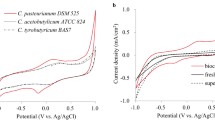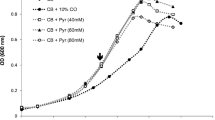Abstract
Clostridium thermocellum has the ability to catabolize cellulosic biomass into ethanol, but acetic acid, lactic acid, carbon dioxide, and hydrogen gas (H2) are also produced. The effect of hydrogenase inhibitors (H2, carbon monoxide (CO), and methyl viologen) on product selectivity was investigated. The anticipated effect of these hydrogenase inhibitors was to decrease acetate production. However, shifts to ethanol and lactate production are also observed as a function of cultivation conditions. When the sparge gas of cellobiose-limited chemostat cultures was switched from N2 to H2, acetate declined, and ethanol production increased 350%. In resting cell suspensions, lactate increased when H2 or CO was the inhibitor or when the cells were held at elevated hyperbaric pressure (6.8 atm). In contrast, methyl-viologen-treated resting cells produced twice as much ethanol as the other treatments. The relationship of chemostat physiology to methyl viologen inhibition was revealed by glucose transport experiments, in which methyl viologen decreased the rate of glucose transport by 90%. C. thermocellum produces NAD+ from NADH by H2, lactate, and ethanol production. When the hydrogenases were inhibited, the latter two products increased. However, excess substrate availability causes fructose 1,6-diphosphate, the glycolytic intermediate that triggers lactate production, to increase. Compensatory ethanol production was observed when the chemostat fluid dilution rate or methyl viologen decreased substrate transport. This research highlights the complex effects of high concentrations of dissolved gases in fermentation, which are increasingly envisioned in microbial applications of H2 production for the conversion of synthetic gases to chemicals.






Similar content being viewed by others
References
Bailey JE, Shurlati A, Hatzimanikatis V, Lee K, Renner WA, Tsai PS (1996) Inverse metabolic engineering: a strategy for directed genetic engineering of useful phenotypes. Biotechnol Bioeng 52(1):109–121
Berberich JA, Knutson BL, Strobel HJ, Tarhan S, Nokes SE, Dawson KA (2000) Product selectivity shifts in Clostridium thermocellum in the presence of compressed solvents. Ind Eng Chem Res 39(12):4500–4505. doi:10.1021/ie0001265
Biswas S, Biswas I (2011) Role of VltAB, an ABC transporter complex, in viologen tolerance in Streptococcus mutans. Antimicrob Agents Chemother 55(4):1460–1469
Bothun GD, Knutson BL, Berberich JA, Strobel HJ, Nokes SE (2004) Metabolic selectivity and growth of Clostridium thermocellum in continuous culture under elevated hydrostatic pressure. Appl Microbiol Biotechnol 65(2):149–157
Bus JS, Aust SD, Gibson JE (1976) Paraquat toxicity: proposed mechanism of action involving lipid peroxidation. Environ Health Perspect 16:139–146
Cotta MA, Russell JB (1982) Effect of peptides and amino acids on efficiency of rumen bacterial protein synthesis in continuous culture. J Dairy Sci 65(2):226–234
Datar RP, Shenkman RM, Cateni BG, Huhnke RL, Lewis RS (2004) Fermentation of biomass-generated producer gas to ethanol. Biotechnol Bioeng 86(5):587–594
Desvaux M (2005) Clostridium cellulolyticum: model organism of mesophilic cellulolytic clostridia. FEMS Microbiol Rev 29(4):741–764. doi:10.1016/j.femsre.2004.11.003
Gaughran ERL (1947) The thermophilic microorganisms. Microbiol Mol Biol Rev 11(3):189–225
Gonzalez-Flecha B, Demple B (1997) Homeostatic regulation of intracellular hydrogen peroxide concentration in aerobically growing Escherichia coli. J Bacteriol 179(2):382–388
Gottschalk G (1986) Bacterial metabolism, 2nd edn. Springer-Verlag, New York
Henstra AM, Sipma J, Rinzema A, Stams AJM (2007) Microbiology of synthesis gas fermentation for biofuel production. Curr Opin Biotechnol 18(3):200–206
Hogsett DA, Ahn HJ, Bernardez TD, South CR, Lynd LR (1992) Direct microbial conversion—prospects, progress, and obstacles. Appl Biochem Biotechnol 34–5:527–541
Lamed R, Zeikus JG (1980) Ethanol production by thermophilic bacteria—relationship between fermentation product yields of and catabolic enzyme activities in Clostridium thermocellum and Thermoanaerobium brockii. J Bacteriol 144(2):569–578
Lamed RJ, Lobos JH, Su TM (1988) Effects of stirring and hydrogen on fermentation products of Clostridium thermocellum. Appl Environ Microbiol 54(5):1216–1221
Lin M, Katsumura Y, Muroya Y, He H, Wu G, Han Z, Miyazaki T, Kudo H (2004) Pulse radiolysis study on the estimation of radiolytic yields of water decomposition products in high-temperature and supercritical water: use of methyl viologen as a scavenger. J Phys Chem A 108(40):8287–8295
MacMichael GJ (1988) Effects of oxygen and methyl viologen on Thermus aquaticus. J Bacteriol 170(10):4995–4998
Mitchell D (2008) A note on rising food prices. World Bank Development Prospects Group. World Bank, Washington
Murray WD, Khan AW (1983) Ethanol production by a newly isolated anaerobe, Clostridium saccharolyticum: effects of culture medium and growth conditions. Can J Microbiol 29(3):342–347
Özkan M, Yilmaz EI, Lynd LR, Özcengiz G (2004) Cloning and expression of the Clostridium thermocellum l-lactate dehydrogenase gene in Escherichia coli and enzyme characterization. Can J Microbiol 50(10):845–851
Pimentel D, Patzek TW (2005) Ethanol production using corn, switchgrass, and wood; biodiesel production using soybean and sunflower. Nat Resour Res 14(1):65–76. doi:10.1007/s11053-005-4679-8
Rao G, Mutharasan R (1987) Altered electron flow in continuous cultures of Clostridium acetobutylicum induced by viologen dyes. Appl Environ Microbiol 53(6):1232–1235
Reimann A, Biebl H, Deckwer WD (1996) Influence of iron, phosphate and methyl viologen on glycerol fermentation of Clostridium butyricum. Appl Microbiol Biotechnol 45(1–2):47–50
Russell JB, Bond DR, Cook GM (1996) The fructose diphosphate/phosphate regulation of carbohydrate metabolism in low G+C Gram-positive anaerobes. Res Microbiol 147(6–7):528–535
Rydzak T, Levin DB, Cicek N, Sparling R (2009) Growth phase-dependant enzyme profile of pyruvate catabolism and end-product formation in Clostridium thermocellum ATCC 27405. J Bacteriol 140(3–4):169–175
Shin HS, Zeikus JG, Jain MK (2002) Electrically enhanced ethanol fermentation by Clostridium thermocellum and Saccharomyces cerevisiae. Appl Microbiol Biotechnol 58(4):476–481. doi:10.1007/s00253-001-0923-2
Strobel HJ, Caldwell FC, Dawson KA (1995) Carbohydrate transport by the anaerobic thermophile Clostridium thermocellum LQRI. Appl Environ Microbiol 61(11):4012–4015
Weimer PJ, Zeikus JG (1977) Fermentation of cellulose and cellobiose by Clostridium thermocellum in absence and presence of Methanobacterium thermoautotrophicum. Appl Environ Microbiol 33(2):289–297
Zeikus JG (1980) Chemical and fuel production by anaerobic bacteria. Annu Rev Microbiol 34:423–464
Acknowledgements
The authors gratefully acknowledge the financial support of the Southeastern Sun Grant Center, administered by the University of Tennessee, grant number DTOS59-07-G-0050. MF was supported by the Agricultural Research Service, USDA. The authors would like to thank Gloria Gellin and Jerry Vice for the technical assistance.
Disclaimer
“Proprietary or brand names are necessary to report factually on available data; however, the USDA neither guarantees nor warrants the standard of the product, and the use of the name by the USDA implies no approval of the product, nor exclusion of others that may be suitable.”
Author information
Authors and Affiliations
Corresponding author
Rights and permissions
About this article
Cite this article
Li, HF., Knutson, B.L., Nokes, S.E. et al. Metabolic control of Clostridium thermocellum via inhibition of hydrogenase activity and the glucose transport rate. Appl Microbiol Biotechnol 93, 1777–1784 (2012). https://doi.org/10.1007/s00253-011-3812-3
Received:
Revised:
Accepted:
Published:
Issue Date:
DOI: https://doi.org/10.1007/s00253-011-3812-3




